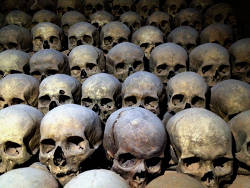Brněnská kostnice
Kostnice u sv. Jakuba
Useful Information
| Location: |
Jakubské náměstí, 658 78 Brno.
(49.196350, 16.607959) |
| Open: |
All year Tue-Sun 9-18. [2020] |
| Fee: |
Adults CZK 140, Children (7-14) CZK 70, Children (0-6) free. Students CZK 70, Seniors CZK 70, Disabled CZK 70, Family (2+2) 320. Groups (20+): 10% discount. [2020] |
| Classification: |
 Catacomb Catacomb
|
| Light: |
 Electric Light Electric Light
|
| Dimension: | |
| Guided tours: | |
| Photography: | allowed |
| Accessibility: | |
| Bibliography: | |
| Address: |
Kostnice u sv. Jakuba, Jakubské náměstí, 658 78 Brno, Tel: +420-515-919-793.
E-mail: |
| As far as we know this information was accurate when it was published (see years in brackets), but may have changed since then. Please check rates and details directly with the companies in question if you need more recent info. |
|
History
| 13th century | cemetry at St. Jakub church already existed. |
| 1784 | abolition of church cemeteries for hygienic reasons. |
| 2001 | rediscovered. |
| 2012 | opened to the public. |
Description

Until recently nobody knew about the existence of the Brněnská kostnice (Brno Ossuary) under St. Jacob’s Square. It was rediscovered in 2001 on a routine exploratory archaeological dig for a new construction project. What they discovered was an underground passage with the bones of approximately 50,000 people. As there is no historic document about this ossuary, it is unclear how it was created. Most likely the bones of the people were removed from the church cemetery of St Jacob church to make room for more burials. The cemetery existed at least since the 13th century, but in the 17th century it was not big enough anymore. There is a theory that people were buried in the cemetery, but after 10 to 12 years they were replaced by the next dead. The bones, which were not gone at that point, were relocated to the osarium (bone house). The remains are believed to be from the 17th and 18th century, a result of an explosion in population in connection with frequent epidemics of plague and cholera. The result is an enormous amount of bones, second only to the catacombs of Paris.
The ossuary was abolished in 1784 as a part of the Josephine reforms. Church cemeteries were closed for hygienic reasons. The remains of the graves were placed in the crypt, the cemetery wall was torn down, and the area was paved with excess tombstones. The ossuary was walled and forgotten.
The bones were originally piled in neat rows filling the tunnel from the floor to the ceiling. But during the centuries the ossuary was flooded by water which relocated the thousands of bones and washed them into a big messy pile. For several years the archeologists worked on returning the crypt to its ordered pre-flood state. Finally, it was reopened as part of several underground sites under the name Kostnice u sv. Jakuba (Ossuary at St. Jakuba).
- See also
 Search DuckDuckGo for "Brněnská kostnice"
Search DuckDuckGo for "Brněnská kostnice" Google Earth Placemark
Google Earth Placemark Brnenská kostnice - Wikipedie, otevrená encyklopedie (
Brnenská kostnice - Wikipedie, otevrená encyklopedie ( )
) Kostnice u sv. Jakuba, official website (visited: 28-SEP-2020)
Kostnice u sv. Jakuba, official website (visited: 28-SEP-2020) 7 Wonders of the (Un)Dead World: Global Ossuaries (visited: 24-FEB-2022)
7 Wonders of the (Un)Dead World: Global Ossuaries (visited: 24-FEB-2022) Brněnská kostnice located in Brno, Czech Republic - Atlas Obscura (visited: 24-FEB-2022)
Brněnská kostnice located in Brno, Czech Republic - Atlas Obscura (visited: 24-FEB-2022) Brno to open ossuary to public after surprise find of 50,000 human bones - Radio Prague (visited: 24-FEB-2022)
Brno to open ossuary to public after surprise find of 50,000 human bones - Radio Prague (visited: 24-FEB-2022)
 Index
Index Topics
Topics Hierarchical
Hierarchical Countries
Countries Maps
Maps